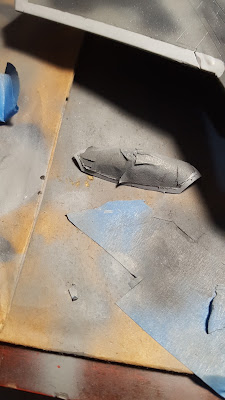Back in January I decided to revitalize my interest in scale models after a three year hiatus in the hobby. My guilt of letting this plane sit in a dusty shoe box was over come when I woke up one day and decided enough was enough.
Scrambling to my drawers, I gathered my brushes, paints and unfinished models determined to reclaim them from the dark cabinets filled with bits of plastic and bugs. I hastily ran to my basement and set up shop on an old table. Paper bags covering the table surface and paints thrown to the back, slowly a sense of excitement returned; my hands tingled with suspense. Could I really be starting this once again?

I took the plane in my hand and glanced over the glossy plastic, desperately waiting to be covered in the matte grey camouflage it deserved. A long time ago I had only finished construction and now I must finish the job. I looked at the instructions, then back to the plane, back and fourth I slowly and careful planned out what to do next. The plane has camouflage, how do I paint that? I checked the internet on techniques and tricks of painting.
This happened to be the first time I used an airbrush to paint. A tool that was some what foreign to me as all my previous models were hand brushed; all I knew was that the pros used them to get a smooth life like paint job. Little did I know that it would become one of my favorite tools.
After priming with Vallejo Base Grey, the first coat of light grey was put up onto the leading edges of all the flat edges. The F-22 raptor is a US fifth generation stealth tactical fighter. With stealth built in, the I knew model had to portray the various elements that define the plane in real life, most importantly the specialized stealth coating paint. To start, the leading edges are painted with special radar absorbing paints to prevent radar return from the most venerable areas. Additionally I attempted to replicate the metallic sheen that the real plane has on its body by mixing the grays with paint metal paints. I don't believe I replicated the effect as well as I could have, which is what I remedied on my more recent F-22 build.
After painting came time to decal up. I used to dread sliding the many barely visible decals and hoping they wouldn't break.
After another clear coat, came the last step, the weathering. The difference between perfection and the reality. In real life its impossible for anything to stay super clean, whether it be dust, grease, oil, you name it, it will be present everywhere. As a model maker it is the final touch to replicate the big world in the small world. Shadows, dust and grime are replicated with washes. I used watered down black paint which seeped into the panel lines to enhance the realism.
As I look back through the eyes of experience I learned many mistakes and new skills that furthered my pursuit in making models as real as I can. This project gained me the knowledge and confidence that was needed to make a second F-22 where I correct the problems I encountered making this one. I will present the next F-22 will be in a future post. Enjoy!
-Patrick






















No comments:
Post a Comment